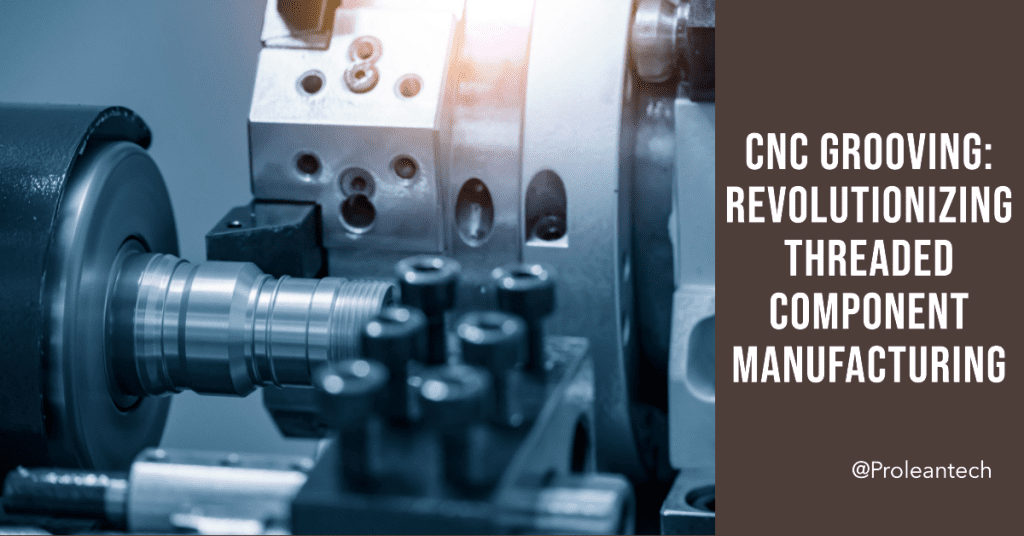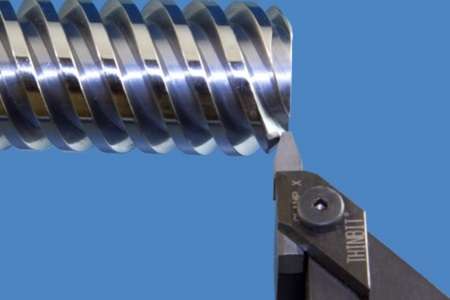Threaded components are ubiquitous in various industries, including automotive, aerospace, medical, and heavy machinery. These components, often characterized by external or internal threads, are key to assembling complex machines and systems. A technique that has significantly revolutionized the manufacturing process of these threaded components is CNC grooving.

CNC grooving is a machining process that uses computer-controlled machines to make precise cuts on a material, resulting in grooves, patterns, or threads that meet exact specifications. The advancements in CNC grooving have led to a significant improvement in the quality and precision of threaded components, making it an essential tool in modern manufacturing. This article will explain how CNC grooving has transformed the production of threaded components, enhancing precision, efficiency, and overall quality, to meet the high standards of diverse industries.
Understanding Threaded Components

Thread grooving
Threaded components are parts that have either external threads (like screws and bolts) or internal threads (like nuts). They are designed to fasten, adjust, or move other parts and are integral to a variety of devices and machines. A thread’s shape, size, and pitch can significantly impact the component’s performance, and hence, precision is paramount in its manufacture.
The importance of precision in the manufacturing of threaded components cannot be overstated. A minor deviation from the specified dimensions can lead to assembly issues, compromising the entire system’s performance. Therefore, manufacturing processes that ensure high precision and consistency, such as CNC grooving, are pivotal in threaded component production.
The Role of CNC Grooving in Threaded Component Manufacturing
CNC grooving plays a crucial role in the manufacturing of threaded components. It ensures the production of high-quality, precision-engineered parts, capable of meeting the exacting demands of various industries. Here’s how:
| Advantages | Description |
|---|---|
| Precision & Consistency | CNC grooving ensures high precision and consistency in producing threaded components. Computer-controlled machines follow exact specifications set in the software, ensuring that every groove and thread is cut with utmost accuracy. |
| Flexibility & Versatility | CNC grooving machines can be programmed to create a wide variety of threads, making them extremely versatile. They can handle standard thread forms like UNC or UNF, as well as specialized ones like ACME or trapezoidal. |
| Efficiency & Productivity | CNC grooving enhances efficiency by automating the grooving process, reducing the time and labor required in traditional methods. It also enables mass production of threaded components without compromising quality, significantly boosting productivity. |
CNC Grooving and Thread Forms
CNC grooving can be used to create various thread forms, each designed for a specific function. Here are a few common ones:
- UN/UNC/UNF Threads: These are standard thread forms used widely in many industries. CNC grooving can create these threads with high precision and speed.
- ACME Threads: ACME threads are usually used in applications where heavy loads are involved. CNC grooving allows for the accurate creation of these robust threads.
- Trapezoidal Threads: These threads are designed for transmitting motion in one direction. CNC grooving ensures the precise creation of these thread forms.
- Buttress Threads: These are specialized threads designed for applications where the force is primarily on one side. CNC grooving allows for the accurate and efficient creation of these threads.
Custom Thread Forms
In addition to standard thread forms, CNC grooving also allows for the creation of custom threads. This is particularly useful in industries where unique, application-specific threads are required. By inputting the specific parameters into the CNC machine, manufacturers can create custom threads that perfectly meet their requirements.
CNC Grooving Process for Threaded Components
The CNC grooving process for threaded components involves several steps, each crucial for achieving the desired precision and quality:
- Design and Programming: The first step is designing the thread form and programming the CNC machine accordingly. This involves specifying the thread dimensions, pitch, and form.
- Material Selection: The next step is choosing the appropriate material for the threaded component. This could be metal, plastic, or any other material suitable for the application.
- Machining: The CNC machine then begins the grooving process, cutting threads into the material with extreme precision. The machine follows the program, ensuring each thread matches the specified design exactly.
- Inspection and Quality Control: The final step is inspecting the threaded components to ensure they meet the required standards. Any components that do not meet the specifications are rejected, ensuring only high-quality parts are shipped.
Applications of CNC Grooving in Threaded Component Manufacturing
CNC grooving finds extensive applications in the manufacturing of threaded components across various industries. Some of these include:
| Industry | Applications |
|---|---|
| Automotive | Engine assembly, suspension systems, and transmission systems |
| Aerospace | Components that can withstand extreme conditions and stresses |
| Medical | Devices and equipment, from surgical instruments to prosthetics |
The Prolean Advantage in CNC Grooving
Prolean is a leader in CNC grooving, offering high-quality machining services for the production of threaded components. With our state-of-the-art CNC machines and experienced team, we ensure the delivery of precision-engineered threaded components that meet your exact specifications. Here’s why Prolean should be your go-to choice for CNC grooving:
- Precision: We understand the importance of precision in threaded component manufacturing and ensure every part we produce meets the highest standards of accuracy.
- Consistency: Our CNC machines ensure consistency in every thread cut, ensuring all your components are uniform and meet the specified standards.
- Efficiency: Our advanced CNC machines automate the grooving process, significantly reducing production time and increasing efficiency.
- Versatility: Whether you need standard thread forms or custom threads, Prolean’s CNC grooving service can handle it all.
Conclusion
CNC grooving has revolutionized the manufacturing of threaded components, offering unparalleled precision, consistency, and efficiency. With its ability to produce a wide variety of thread forms, it is an indispensable tool in modern manufacturing. Prolean’s CNC grooving service is at the forefront of this revolution, delivering high-quality threaded components that meet the exacting standards of various industries.
FAQs
What is CNC grooving?
CNC grooving is a machining process that uses computer-controlled machines to cut grooves or threads into a material with high precision.
Why is CNC grooving important in threaded component manufacturing?
CNC grooving is crucial in threaded component manufacturing because it ensures high precision, consistency, and efficiency. It allows for the creation of a wide variety of thread forms, including custom threads.
What industries use CNC grooving for threaded component manufacturing?
CNC grooving is used in various industries, including automotive, aerospace, medical, and heavy machinery, for the manufacturing of threaded components.
What is the advantage of using Prolean’s CNC grooving service?
Prolean’s CNC grooving service offers high precision, consistency, and efficiency in threaded component manufacturing. With advanced CNC machines and an experienced team, Prolean ensures the delivery of high-quality threaded components that meet your exact specifications.




Thanks for sharing insights of CNC grooving operations! I must say it is very clear and easy to understand.